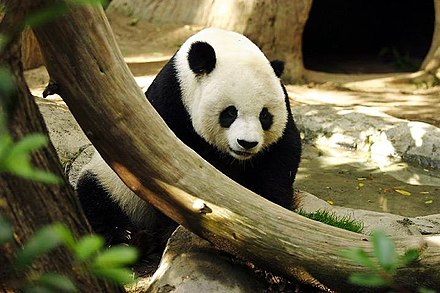The giant panda (Ailuropoda melanoleuca) is a large mammal native to China and very popular around the world. It is a national treasure of China and is regarded as a symbol of nature conservation. Here are some key features about giant pandas:

1. Appearance features:
Color: The most distinctive feature of giant pandas is the color of their fur. Their body hair is mainly white, with black on the nose, around the eyes, ears, shoulders, forearms and hind legs, giving them a very contrasting coloration.
Size: The giant panda is the smallest member of the bear family. The weight of an adult giant panda usually ranges from 75 to 125 kilograms, and the shoulder height is about 60 to 90 centimeters.
2. Eating habits:
The main food is bamboo: Although the taxonomy belongs to the order Carnivora, the main food of giant pandas is bamboo, and they can eat 14 different species. Bamboo accounts for up to 99% of the giant panda's diet. Other foods include some grasses, wild fruits, and even mouse or bird eggs.
Thumb: Giant pandas have 5 fingers and a "thumb". This "thumb" is actually a protruding wrist bone that helps the giant panda grip bamboo tightly for gnawing.
3. Behavioral habits:
Solitary life: Most of the time, giant pandas live alone. Except during the breeding season, the only social interaction between the mother bear and her cubs is for the mother bear to feed and educate her cubs.
Arboreal habits: Giant pandas like to rest and play in trees, which is also a very important survival skill for them.
Altitude distribution: In the natural environment, giant pandas usually live in moist bamboo forests at an altitude of 1,200 to 3,400 meters.
4. Reproductive characteristics:
Reproduction: The reproduction rate of giant pandas is low. Their main reproductive season is in spring, and female bears give birth to cubs every two years. The length of pregnancy in giant pandas is uncertain, but may range from 3 months to 5 months.
Cubs: Newly born giant panda cubs are very small, only 90 to 130 grams, which is 1/800 of the weight of giant pandas. This is the smallest ratio of newborn to adult weight among mammals.
5. Protection status:
Endangered status: Due to deforestation, agricultural expansion and other reasons, the giant panda's living environment is seriously threatened, making it one of the most endangered animals in the world.
Conservation actions: In order to protect giant pandas, the Chinese government has established a number of giant panda reserves and also launched giant panda breeding projects in an effort to increase the number of giant pandas.
Overall, the giant panda has become one of the most popular and recognized animals in the world with its unique appearance, unique eating habits and social habits.
animal tags:
We created this article in conjunction with AI technology, then made sure it was fact-checked and edited by a Animals Top editor.